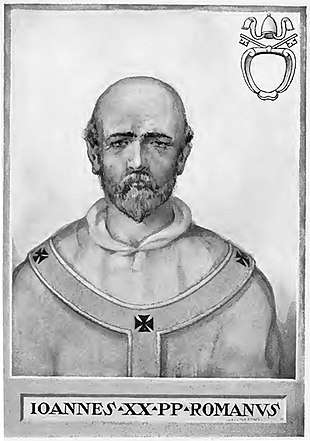Pope John XIX
| Pope John XIX | |
|---|---|
 | |
| Papacy began | April 1024[1] |
| Papacy ended | October 1032 |
| Predecessor | Benedict VIII |
| Successor | Benedict IX |
| Personal details | |
| Birth name | Romanus |
| Born |
Unknown Rome, Papal States, Holy Roman Empire |
| Died |
October 1032 Rome, Papal States, Holy Roman Empire |
| Other popes named John | |
Pope John XIX (Latin: Ioannes XIX; died October 1032) was Pope from May 1024 to his death in 1032.
Life
Born Romanus in Rome was the third son of Gregory I, Count of Tusculum and his wife Mary. While his brother Theophylactus held the papacy as Pope Benedict VIII, Romanus held the temporal power in the city as consul and senator. Upon the death of Benedict, Romanus, a layman, was elected to succeed him. He was immediately ordained in all the orders in succession, and consecrated bishop in order to enable him to ascend the papal chair. He took the name of John.[2]
He played a role in the process leading to the Schism of 1054 by rejecting a proposal by Patriarch Eustathius of Constantinople to recognise that Patriarchate's sphere of interest in the east.[3] Against the grain of ecclesiastical history, John XIX agreed, upon being paid a large bribe, to recognize the Patriarch of Constantinople's claim to the title of ecumenical bishop. However, this proposal excited general indignation throughout the Church, compelling him almost immediately to withdraw from the agreement.
John invited the celebrated musician, Guido of Arezzo, to visit Rome and explain the musical notation invented by him. He encouraged the Benedictine to instruct the Roman clergy in music.[4]
On the death of the Emperor Henry II in 1024, he gave his support to Emperor Conrad II, who along with his consort was crowned with great pomp at St. Peter's Basilica on Easter of 1027. Two kings, Rudolph of Burgundy and Canute of Denmark and England, took part in this journey to Rome.[2] Consistent with his role as a Christian king, Cnut went to Rome to repent for his sins, to pray for redemption and the security of his subjects, and to improve the conditions for pilgrims, as well as merchants, on the road to Rome. Rudolph had control of many of the toll gates. Negotiations being successful, the solemn word of the Pope, the Emperor and Rudolph was given with the witness of four archbishops, twenty bishops, and "innumerable multitudes of dukes and nobles",[5] suggesting it was before the ceremonies were completed.
In 1025 he sent the crown to Poland and blessed the coronation of the Polish king Bolesław I the Brave.[6]
On 6 April 1027, John held a Lateran synod in which he declared for the Patriarch of Aquileia against the Patriarch of Grado, giving its bishop, Poppo of Aquileia, the patriarchal dignity and putting the bishop of Grado under his jurisdiction. In fact, the patriarch took precedence over all Italian bishops. In 1029, John revoked his decision and reaffirmed all the dignities of Grado. John also enacted a Papal Bull endowing Byzantius, Archbishop of Bari, with the right to consecrate his own twelve suffragans after the reattachment of the Bariot diocese to Rome in 1025. This was part of a conciliatory agreement with Eustathius, whereby the existence of the Byzantine Rite would be allowed in Italy in exchange for the establishment of Latin Rite churches in Constantinople.[7]
Pope John XIX took the Abbey of Cluny under his protection, and renewed its privileges in spite of the protests of Goslin, Bishop of Macon. He offered Odilo of Cluny the archbishopric of Lyons, but Odilo refused and the pope then chided Odilo for disobedience. John XIX died shortly after and his successor (Benedict IX) did not press the matter any further.[8]
He was said to have been killed by a mob of angry peasants, but there is no evidence to support this. The actual cause of death is unknown.
After John XIX's death, his nephew Pope Benedict IX was found as a successor, although he was still young; according to some sources, he was only 12, but he was more likely to have been about 18 or 20.
The next Pope named John was Pope John XXI (1276–77); there is no Pope John XX (see article on John XX for an explanation).
See also
References
- ↑ "John XIX", The Holy See
- 1 2 Kirsch, Johann Peter. "Pope John XIX (XX)." The Catholic Encyclopedia Vol. 8. New York: Robert Appleton Company, 1910. 8 November 2017
- ↑ Previté-Orton, p. 275.
- ↑ Brusher SJ, Joseph S., "John XIX – The Layman Pontiff", Popes Through the Ages, (1980) San Rafael, California: Neff-Kane
- ↑ Trow, M. J. (2005), Cnut – Emperor of the North, Stroud: Sutton, ISBN 0-7509-3387-9, p. 193
- ↑ Halecki, Oscar and W. F. Reddaway, J. H. Penson, The Cambridge History of Poland, (Cambridge University Press), 67.
- ↑ Runciman, p. 123.
- ↑ Smith, Lucy Margaret. The Early History of the Monastery of Cluny. Oxford University Press, 1920
Sources


- Runciman, Steven. Byzantine Civilisation. London, University Paparback, 1961.
![]()
| Catholic Church titles | ||
|---|---|---|
| Preceded by Benedict VIII |
Pope 1024–32 |
Succeeded by Benedict IX |

